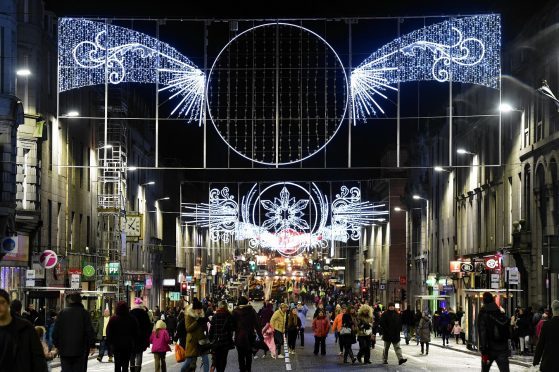Scottish shoppers delivered a boost to the high street in December while their UK counterparts favoured staying home and buying their presents in the internet, new figures have revealed.
In the weeks before Christmas, footfall numbers in Scotland were 0.2% higher on the same month last year, and were significantly above the 4.2% fall in November 2015, according to the Scottish Retail Consortium (SRC).
The researchers hailed this as the “best footfall performance” since April 2015.
In comparison, the number of people hitting the shops across the UK was 2.2% down on average, and marginally lower than the 2.1% decline in November.
Those who did venture outside preferred out-of-town retail parks, which welcomed 2.1% more shoppers year-on-year. High streets and shopping centres were hit by a further decline in footfall, falling to 4% and 2% respectively, marking the sharpest decline for city centre high streets since November 2014.
Scotland was the only region in the UK to report a rise in footfall.
David Lonsdale, director of the SRC, said: “Buoyed by Christmas, cheaper petrol and by retailers’ own promotional and pricing efforts, this was a more encouraging end to the year for shopper footfall in Scotland.The growth in shopper numbers last month may only have been a smidgen higher than in the same period the year before, however it comes as welcome relief after declining figures in each of the previous seven months.
“The challenge for our town centres will be turning this into a more sustained uptick in the months ahead particularly as the popularity of online shopping and click and collect services continues to soar, providing ever greater choice and convenience for customers. The challenge for retailers as ever is to turn browsing into buying, and we await figures later this week to see if higher footfall lead to a commensurate rise in the total value of retail sales.”
Diane Wehrle, marketing and insights director at Springboard, which undertoook the research, said: “Across the UK the surge in online spending in December clearly impacted heavily on traditional urban retail destinations, the catalyst being the plethora of online discounts on Black Friday which then continued throughout December.
“The drop of 4% in UK high street footfall was the most severe since November 2014, and far deeper than the drop of 1.8% in December 2014. However, high streets in Scotland had greater resiliency, with a far more modest drop in footfall of just 0.1%.
In contrast footfall dropped by 5.1% in shopping centres in Scotland, despite the fact that with their concentration of multiple retailers they are usually considered to be a safe and reliable option for Christmas shopping.
“Much has been mentioned of the ongoing success of retail parks over the last two years in growing their shopper base and – whilst the volumes of footfall in these destinations remain far lower than in either high streets or shopping centres – in concert with online, they clearly represent an increasingly strong draw for shoppers.
Whilst urban destinations undoubtedly have long term immovable constraints in terms of their built fabric, retailers trading in these locations need to harness the opportunities created by the new shopping reality – a demand for greater convenience, choice and customer service – and deliver offers and environments that excite and entertain shoppers, so incentivising them to abandon the sofa and tablet for the store.”
